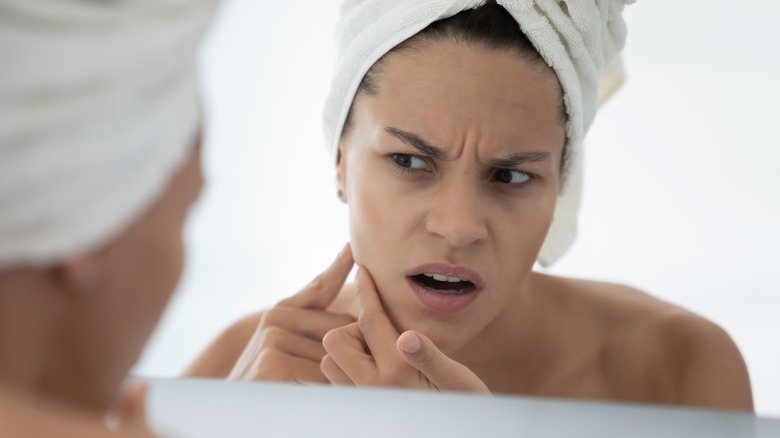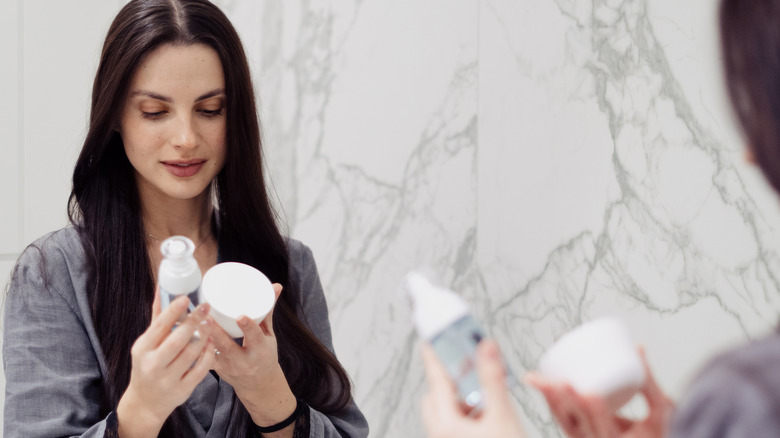How To Identify & Treat Comedonal Acne, According To Our Dermatologist
Pretty much everyone suffers from acne at some point in their lives. While it's normal to get flare-ups as a teen, getting acne as an adult is not only annoying but also affects self-esteem. But before you can treat your acne, you need to identify which type you have. According to GoodRX Health, acne typically falls into three main categories: comedonal, inflammatory, and nodulocystic. The latter is the most difficult to treat, as the acne resides "under the skin" and can hurt quite a lot. Meanwhile, inflammatory acne describes your regular run-of-the-mill pimple and can break out when your pores are clogged, and if you have blackheads or whiteheads, you're dealing with comedonal acne.
To understand comedonal acne better, we spoke exclusively to board-certified dermatologist Dr. Jenny Liu, who provides skincare advice on Instagram, TikTok, and YouTube. And, luckily for us, she gave us the professional lowdown on what it is and how to treat it. "They are the start of acne and can be seen alone or mixed with more inflammatory acne like zits," Dr. Liu told us, adding that comedonal acne happens when sebum, dead skin, and bacteria build up in your pores. Thankfully, it can be treated easily at home, and if you need more help, you can always go to your dermatologist for a prescription.
Skincare ingredients to look for when treating comedonal acne
When assessing if you have comedonal acne, Dr. Jenny Liu exclusively told Glam, "[Look for] black and white heads situated around pores." She informed us that blackheads occur when pores open up and your sebum oxidizes. To treat this type of acne, Dr. Liu shared that you'll need to find products with "ingredients that help to unclog pores and improve skin turnover." Adapalene and salicylic acid are both great over-the-counter (OTC) remedies for comedonal acne, she told us.
Adapalene, which is also known by the brand name Differin, was once available through a prescription only, but the FDA approved it for over-the-counter use in 2016. Although it's OTC, it should be noted that women who are pregnant or breastfeeding should consult with their doctor prior to using Differin. Salicylic acid, which can be used every day, is found in many skincare products used to treat acne and works well for comedonal acne, according to Healthline. The beta-hydroxy acid (BHA) empties the pores by breaking down and disposing of dead skin cells. If you need a stronger treatment, Dr. Liu advised asking your dermatologist for a prescription retinoid such as tretinoin.
How to prevent future breakouts
If you've cleared up your acne flare-up, you'll want to do your best to prevent it from happening again. Speaking exclusively to Glam, Dr. Jenny Liu suggested using your anti-acne products regularly, especially if you're skin is prone to breaking out. She also advised that folks "[avoid] super occlusive products that may lead to more clogged pores, like petrolatum." As explained by professors at Michigan State University, occlusives are skincare ingredients like the aforementioned petrolatum — as well as olive oil, coconut oil, castor oil, beeswax, and more — that build and maintain a shield on the skin's surface to regulate its moisture. While those ingredients are super hydrating, the barrier they form on your skin can potentially clog your pores, as Dr. Liu told us, and cause breakouts.
According to Dr. Liu, skincare isn't the only thing you should be mindful of when it comes to your face. She warned those fighting acne to be careful of haircare products that can come into contact with your skin, as certain ingredients can aggravate or cause comedonal acne. In addition, try not to touch your face too often, and keep it clear of anything that can cause friction, as all of these matters can also lead to breakouts.


